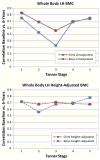Longitudinal tracking of dual-energy X-ray absorptiometry bone measures over 6 years in children and adolescents: persistence of low bone mass to maturity
- PMID: 24485819
- PMCID: PMC4035430
- DOI: 10.1016/j.jpeds.2013.12.040
Longitudinal tracking of dual-energy X-ray absorptiometry bone measures over 6 years in children and adolescents: persistence of low bone mass to maturity
Abstract
Objectives: Early assessment of bone mass may be useful for predicting future osteoporosis risk if bone measures "track" during growth. This prospective longitudinal multicenter study examined tracking of bone measures in children and adolescents over 6 years to sexual and skeletal maturity.
Study design: A total of 240 healthy male and 293 healthy female patients, ages 6-17 years, underwent yearly evaluations of height, weight, body mass index, skeletal age, Tanner stage, and dual-energy x-ray absorptiometry (DXA) bone measurements of the whole body, spine, hip, and forearm for 6 years. All subjects were sexually and skeletally mature at final follow-up. Correlation was performed between baseline and 6-year follow-up measures, and change in DXA Z-scores was examined for subjects who had baseline Z < -1.5.
Results: DXA Z-scores (r = 0.66-0.87) had similar tracking to anthropometric measures (r = 0.64-0.74). Tracking was stronger for bone mineral density compared with bone mineral content and for girls compared with boys. Tracking was weakest during mid- to late puberty but improved when Z-scores were adjusted for height. Almost all subjects with baseline Z < -1.5 had final Z-scores below average, with the majority remaining less than -1.0.
Conclusions: Bone status during childhood is a strong predictor of bone status in young adulthood, when peak bone mass is achieved. This suggests that bone mass measurements in children and adolescents may be useful for early identification of individuals at risk for osteoporosis later in life.
Copyright © 2014 Elsevier Inc. All rights reserved.
Conflict of interest statement
The authors declare no conflicts of interest.
Figures




Comment in
-
Low bone density during childhood: what does it predict?J Pediatr. 2014 Jun;164(6):1252-4. doi: 10.1016/j.jpeds.2014.01.042. Epub 2014 Mar 5. J Pediatr. 2014. PMID: 24607245 No abstract available.
References
-
- Gilsanz V, Kovanlikaya A, Costin G, Roe TF, Sayre J, Kaufman F. Differential effect of gender on the size of the bones in the axial and appendicular skeletons. J Clin Endocrinol Metab. 1997;82:1603–7. - PubMed
-
- Gilsanz V, Roe TF, Mora S, Costin G, Goodman WG. Changes in vertebral bone density in black girls and white girls during childhood and puberty. N Engl J Med. 1991;325:1597–600. - PubMed
-
- Burrows M, Baxter-Jones A, Mirwald R, Macdonald H, McKay H. Bone mineral accrual across growth in a mixed-ethnic group of children: are Asian children disadvantaged from an early age? Calcif Tissue Int. 2009;84:366–78. - PubMed
Publication types
MeSH terms
Grants and funding
- N01-HD-1-3331/HD/NICHD NIH HHS/United States
- N01 HD013329/HD/NICHD NIH HHS/United States
- N01-HD-1-3332/HD/NICHD NIH HHS/United States
- N01 HD013331/HD/NICHD NIH HHS/United States
- N01 HD013328/HD/NICHD NIH HHS/United States
- N01-HD-1-3329/HD/NICHD NIH HHS/United States
- N01 HD013333/HD/NICHD NIH HHS/United States
- UL1 RR024134/RR/NCRR NIH HHS/United States
- N01-HD-1-3228/HD/NICHD NIH HHS/United States
- N01-HD-1-3330/HD/NICHD NIH HHS/United States
- N01-HD-1-3333/HD/NICHD NIH HHS/United States
- N01 HD013332/HD/NICHD NIH HHS/United States
- UL1 RR026314/RR/NCRR NIH HHS/United States
- N01 HD013330/HD/NICHD NIH HHS/United States
LinkOut - more resources
Full Text Sources
Other Literature Sources
Medical
Molecular Biology Databases

